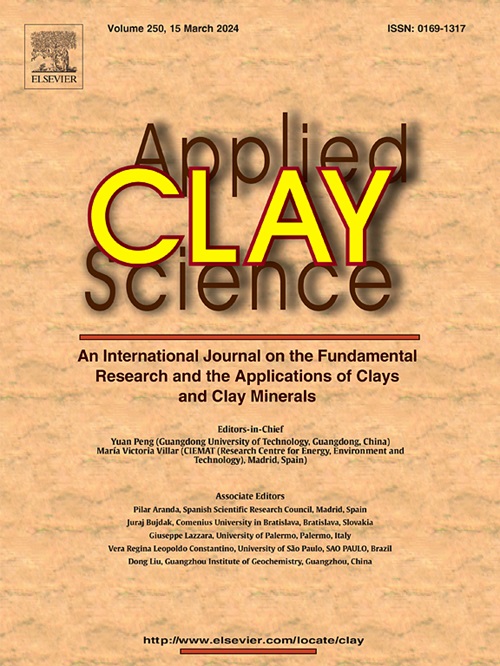Deposition and release of clay colloids on alumina and natural organic matter surfaces via heterogeneous pathways
IF 5.3
2区 地球科学
Q2 CHEMISTRY, PHYSICAL
引用次数: 0
Abstract
Clay colloids are ubiquitous on land and in aquatic environments. Because of their overall negative surface charge, the impact of surface charge heterogeneity has long been overlooked. In this work, we demonstrate that both the deposition and the release of montmorillonite colloids (MONTs) are influenced by surface charge heterogeneity, both on positively charged metal oxide (alumina) surfaces and negatively charged natural organic matter (NOM: humic acid and alginate) surfaces. Deposition trends show that MONTs has the highest attachment on alginate, due to the positive charge and rich hydroxyl functional groups at the edges of MONTs, as well as the coarser surface produced by the extended conformation of alginate macromolecules. At very low ionic strength (IS), MONTs can deposit onto alumina in a face-face adsorption manner due to electrostatic attraction, while no deposition occurs on NOM because of electrostatic repulsion. At high IS, the compression of the basal surface electrical double layer (EDL) exposes the edge EDL of the MONTs, leading to significant deposition on the NOM via the edge. In addition, on the MONT layer already deposited on the alumina surface, small particles of MONT also further deposit via the edge adsorption. When divalent ions are present, in addition to the EDL compression a cation bridge effect between the edges of the MONTs and the NOM surface occurs, thereby reducing release. These findings provide new insights into the study of the deposition behavior of charge-heterogeneous colloids, such as MONTs, in the environment.

粘土胶体在氧化铝和天然有机物质表面的沉积和释放通过非均相途径
粘土胶体在陆地和水生环境中普遍存在。由于其表面电荷总体为负,表面电荷非均质性的影响长期被忽视。在这项工作中,我们证明了蒙脱土胶体(MONTs)的沉积和释放都受到表面电荷异质性的影响,无论是在带正电的金属氧化物(氧化铝)表面还是带负电的天然有机物(NOM:腐植酸和海藻酸盐)表面。沉积趋势表明,由于MONTs边缘的正电荷和丰富的羟基官能团,以及藻酸盐大分子扩展构象产生的较粗糙的表面,MONTs在藻酸盐上的附着力最高。在离子强度很低的情况下,由于静电吸引,MONTs可以以面吸附的方式沉积在氧化铝上,而由于静电排斥,在NOM上不会发生沉积。在高IS下,基底表面电双层(EDL)的压缩暴露了mont的边缘EDL,导致通过边缘在NOM上显著沉积。此外,在已经沉积在氧化铝表面的MONT层上,MONT的小颗粒也通过边缘吸附进一步沉积。当二价离子存在时,除了EDL压缩外,mont边缘和NOM表面之间还会发生阳离子桥效应,从而减少释放。这些发现为研究电荷非均相胶体(如mont)在环境中的沉积行为提供了新的见解。
本文章由计算机程序翻译,如有差异,请以英文原文为准。
求助全文
约1分钟内获得全文
求助全文
来源期刊

Applied Clay Science
地学-矿物学
CiteScore
10.30
自引率
10.70%
发文量
289
审稿时长
39 days
期刊介绍:
Applied Clay Science aims to be an international journal attracting high quality scientific papers on clays and clay minerals, including research papers, reviews, and technical notes. The journal covers typical subjects of Fundamental and Applied Clay Science such as:
• Synthesis and purification
• Structural, crystallographic and mineralogical properties of clays and clay minerals
• Thermal properties of clays and clay minerals
• Physico-chemical properties including i) surface and interface properties; ii) thermodynamic properties; iii) mechanical properties
• Interaction with water, with polar and apolar molecules
• Colloidal properties and rheology
• Adsorption, Intercalation, Ionic exchange
• Genesis and deposits of clay minerals
• Geology and geochemistry of clays
• Modification of clays and clay minerals properties by thermal and physical treatments
• Modification by chemical treatments with organic and inorganic molecules(organoclays, pillared clays)
• Modification by biological microorganisms. etc...
 求助内容:
求助内容: 应助结果提醒方式:
应助结果提醒方式:


